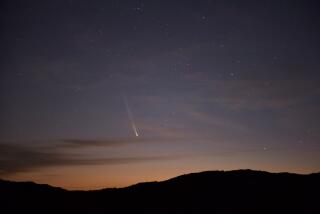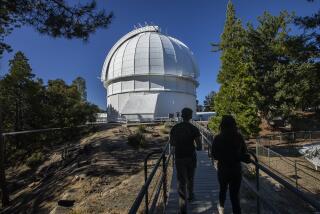A Star Is Born : Student Makes a Name for Herself and a New Comet
- Share via
When Christine Wilson saw a smear on the photographic plate she took from a telescope at Palomar Observatory on Aug. 5, she had no thought of discovering a comet, much less having one named for her.
But after some doubt, questioning, research and tracking, Comet Wilson has been confirmed and its discoverer has become a new star of sorts among astronomers.
Wilson was on her summer job at the observatory northeast of San Diego as part of Caltech’s Palomar Sky Survey, which will make about 2,700 overlapping photographic plates of the sky over the next several years.
Photographic Evidence
The 24-year-old Caltech astronomy student was using the observatory’s 48-inch Schmidt telescope to photograph a field of faint galaxies when the comet showed up on a plate as a smear with a trail about a millimeter long and a quarter of a millimeter wide.
“I could see it, and I knew it was bright,” she said in an interview this week. “My co-workers and I looked up known comets and didn’t see any that matched.”
From there she proceeded with what her Caltech adviser said are her special gifts. “She has guts and perseverance, which are more important than brains,” said Caltech astronomy professor Wallace Sargent.
Wilson said the International Astronomical Union in Cambridge, Mass., a clearinghouse for astronomical finds, at first discounted her discovery because, “we estimated the magnitude wrong. We thought it was brighter than it turned out to be.”
Confirmation From France
But Alain Maury, a French photographer who worked with her on the Sky Survey, called a French observatory for verification, which Wilson said helped convince the International Astronomical Union of her discovery.
Wilson may get her only chance to see the comet “up close” next year.
Comet Wilson, now about 320 million miles from the sun, is expected to come within 50 or 60 million miles of Earth next April, when it will be visible only in the Southern Hemisphere.
It could be millions of years before the comet comes that close to Earth again.
“I hope to go down and see it myself,” said the young astronomer.
Likely Viewing Places
Sargent said the likely places to view the comet then will be in Australia, Chile and South Africa.
According to officials at Caltech, astronomers have not been able to determine the exact orbit of the comet, but believe that it is a “long-period” comet. Such comets can take millions of years to circle the sun.
Astronomers also have not determined if this will be the comet’s first close approach to Earth.
“I was really excited a month ago,” Wilson said of her discovery and its confirmation as a comet. Since then she has completed her summer work and returned to the Pasadena campus and the Altadena house she shares with several other Caltech students.
Comets traditionally are named for their finders. Between 10 and 15 are discovered every year, most of them long-period comets, a Caltech spokesman said. There are an estimated 1,000 recorded comets, but only about 100 make short-period orbits of less than 100 years around the sun, as Halley’s comet does every 76 years.
According to officials at Caltech, “Comet Wilson is distinguished by its size, brightness and the lead time between discovery and perihelion,” the term for the comet’s closest approach to the sun. The lead time will give the astronomers an opportunity to track its orbit.
Although astronomers cannot tell the exact size of the Wilson comet, they estimate by its brightness that it may be in the same category as Halley’s comet, which has a mass of about 1 billion tons.
A native of Cambridge, Mass., Wilson, who has dual citizenship, grew up in Toronto, Canada, where her Canadian father is an economics professor at the University of Toronto and her mother, a U.S. citizen, trained as a physiotherapist.
During her undergraduate studies at the University of Toronto, Wilson said she was a physics major who became fascinated with astronomy.
She May Become Teacher
“You really need a lot of physics to do astronomy,” she said, and she hopes someday to teach and do research at a university.
Having spent three- and four-day stints all summer atop Mt. Palomar, 6,126 feet up in San Diego County, Wilson experienced the isolation and night work that astronomy entails, but it has not deterred her.
Although she called herself “a social animal,” Wilson also said that “I like to work on my own.”
Being able to work alone in remote places, and often with no reward, is essential for an astronomer, Sargent said. And Wilson, he said, “is really gifted in this business where unexpected things happen, and often you work for years and nothing happens at all.”.




